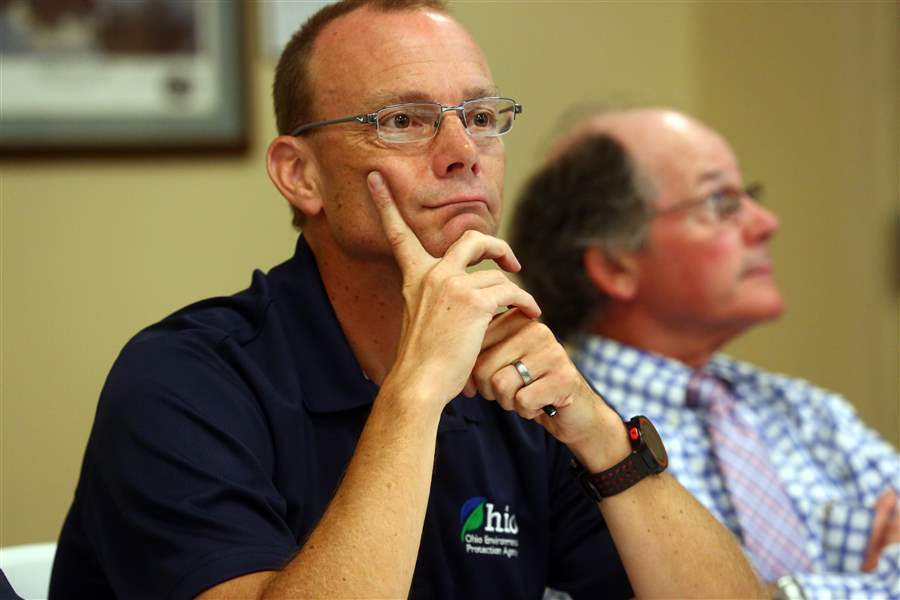
Activist's charges anger state EPA chief
1/28/2018
Craig Butler, director of the Ohio Environmental Protection Agency.
The Blade
Buy This Image

Craig Butler, director of the Ohio Environmental Protection Agency.
The Ohio Environmental Protection Agency’s top official said he is incensed that one of northwest Ohio’s highest-profile environmentalists accused his agency of lying and engaging in a cover-up over a planned $700 million iron-briquette manufacturing facility along the Maumee River in East Toledo.
“I don’t know how to react strongly enough to that. This is almost outright slanderous,” Ohio Environmental Protection Agency Director Craig Butler told The Blade. “This is something I’m not going to take sitting down. I’m going to take her to task for it.”
He was referring to comments made by Sandy Bihn, an Oregon resident who has won numerous awards for environmental activism. She is concerned the future Cleveland-Cliffs Inc. plant, slated to begin operation in 2020, will be an eyesore and a local health hazard. She also is worried it will spew soot on boats plying the Maumee River as the city of Toledo tries to get the Marina District developed and build on the momentum generated in 2017 by the grand opening of ProMedica’s headquarters downtown, as well as the city’s reconfigured Promenade Park.
Ms. Bihn, Lake Erie Waterkeeper founder and Lake Erie Foundation executive director, accused the Ohio EPA of purposefully withholding information about a controversial iron-briquette facility in Portland, Texas, at a Jan. 18 public hearing the agency held in the Waite High School cafeteria to discuss what Cleveland-Cliffs has planned for this area.
Ms. Bihn — a longtime Oregon councilman and former clerk auditor, tax commissioner, and finance director for the city — maintains there are enough similarities that the Ohio EPA should have at least been more forthcoming and transparent about the Texas facility, owned and operated by Voestalpine, an Austrian steel company.
VIDEO: Portland, Texas TV report on pollution near Voestalpine iron plant
Myriad pollution issues that have emerged in Texas are mostly related to how Voestalpine manages and controls dust. According to news reports, residents near that plant are angry that a local waterway has turned red. Many complain of iron-ore soot on their homes and cars.
Ms. Bihn contends the technology used in Texas — while not identical to what Cleveland-Cliffs proposes to use along the Mamuee River — is close enough to have at least merited a discussion at the meeting.
Instead, according to Ms. Bihn’s recollection, those who attended the public hearing in Toledo were told the Cleveland-Cliffs project is the first of its kind in the nation. But Mr. Butler’s spokesman, Heidi Griesmer, said the meeting transcript shows a company official stated the Toledo project would be a first for Cleveland-Cliffs only, not for the industry at large.
That, according to Ms. Bihn, is splitting hairs.
“The fact [the Ohio EPA] didn’t disclose it at the hearing is just fact,” she said. “It was outrageous what they did. It was just outrageous. They covered it up.”
In her post-hearing written comments to the agency, Ms. Bihn accuses the Ohio EPA of making false statements to the public.
When asked if he was hinting at legal action against Ms. Bihn, Mr. Butler said she “certainly is going to get a letter from me.”
“It’s garbage,” he said of her accusations.
This much is clear, though: The Ohio EPA knew about pollution emanating from the Texas site before it went into the public hearing.
The issue there mostly pertains to what is known as “fugitive dust” — that is, errant iron-ore dust particles that are not properly managed or stored correctly, as opposed to smokestack emissions.
“Yes, we knew about the facility in Texas,” Mr. Butler said. “Yes, we knew about the problems of fugitive dust.”
Furthermore, David Cartella, Cleveland-Cliffs vice president of government and environmental affairs, said the Ohio EPA contacted the Texas Commission on Environmental Quality about the pollution there while reviewing the company’s permit application. That was done to avoid a similar situation in Toledo, he said.
“I know they were in touch with them. I know that’s why they were hard on us,” Mr. Cartella said.
The company itself was aware of the Texas controversy and used lessons from it in the final Cleveland-Cliffs design, he said. “We were aware of their issues and were determined to make sure we didn’t make the same missteps. We did learn from them what not to do. ... We’re really, really comfortable we’re not going to have the same issues they’re having down in Texas.”
A Cleveland-Cliffs fact sheet said the company included information about the Texas facility in its permit applications to the Ohio EPA and the city of Toledo. It said Texas authorities found 20 unpermitted and unregulated piles of material releasing dust.
Cleveland-Cliffs is proposing to build a facility that will make iron briquettes from taconite pellets, with natural gas as the plant’s fuel. The pellets are produced at one of the company’s three northern Minnesota facilities. The East Toledo facility would be strictly what is known in the industry as an HBI plant, an abbreviation for hot-briquetted iron.
Precautions are being made to ensure the shipment and storage of those materials is as dust-free as possible, said Clifford T. Smith, Cleveland-Cliffs executive vice president of business development and the executive in charge of the Toledo project.
“We’re a 171-year-old company that has been making iron-ore pellets for 55 to 60 years. We know how to handle them without creating dust,” Mr. Smith said. “We’re not going to have unpermitted, unregulated piles [of iron ore] on the ground like the Texas facility.”
VIDEO: Portland, Texas residents register concerns about waste from iron ore plant
Ms. Bihn and others also have raised concerns about real-time monitoring and noise. Decisions on where and what types of monitors to use will be made by the Ohio EPA, while decisions about noise will be left up to the city of Toledo, Mr. Smith said.
He said emissions will be controlled by a series of baghouses and smokestack scrubbers, and that there will be suppression systems at every transfer point to minimize dust.
But there are no plans to install selective catalytic reduction technology, one of the best — but also one of the most expensive — ways of neutralizing airborne emissions. The size and volume of the project doesn’t justify costs, Mr. Cartella said.
“We’re not going to exceed any standards,” Mr. Cartella said.
The Ohio EPA said the main pollutants released will be carbon monoxide, nitrogen oxides, particulate matter, and greenhouse gas pollutants. The plant is to be built at Front Street and Millard Avenue, on part of the former Gulf Oil refinery site.
The end product, the iron briquettes, will be used by area steel mills, including North Star BlueScope Steel LLC in Delta, Ohio, to make automotive body parts and other products. The Toledo plant is to employ 130 people.
Contact Tom Henry at thenry@theblade.com, 419-724-6079, or via Twitter @ecowriterohio.